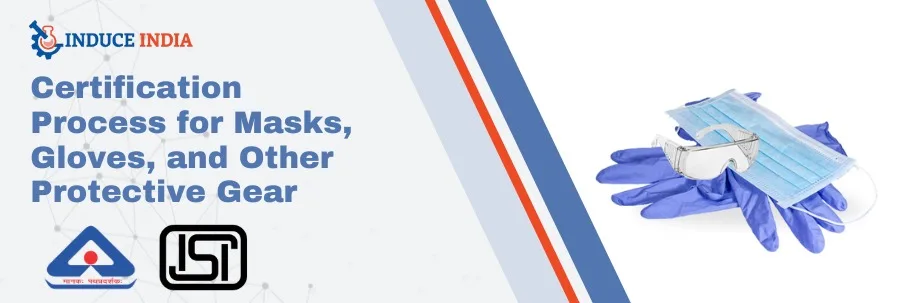In the world of daily accidents and mishappening; safety, and health become very important for each individual. You never know what can happen to you next, Hence everyone needs to keep protective gear such as masks, gloves, and other protective equipment along with them.
These protective gear play a crucial role in safeguarding individuals from various hazards. Specifically, those who are working on construction sites, hospitals, mines, etc.
All types of protective gear are important but not all of them are created equal.
The manufacturers need to make these protective gear with top quality so that they can actually save the lives of people. BIS certification ensures the same. It ensures that these products meet specific standards of quality and safety.
In this article, you will learn about the certification process involved in acquiring BIS certification for masks, gloves, and other protective gear.
What is BIS Certification?
Bureau of Indian Standards (BIS) Certification is a mark of quality, safety, and reliability for products in India. It is a mandatory mark for various products to ensure that predefined standards of safety and quality are met. In the year 1987, the Indian Standard Institute (ISI) transformed and was bestowed with the new title of Bureau of Indian Standard (BIS).
It gives an official symbol to the manufacturers known as the ISI mark. At present, obtaining an ISI mark serves as a stamp of approval. The product must successfully pass the BIS test and certification process, ensuring that the quality standards are met properly. Without this mark, manufacturers cannot stay for long in the market, since this mark is directly connected with the customer’s trust and safety.
Why Does BIS Certification Matter?
BIS certification is important because it acts as proof of the quality of your product. Customers can check the quality of your products by looking at the ISI mark on your products. This mark ensures that your product meets the quality and safety standards and does not harm any customer while using it.
BIS certification for protective gear ensures that those gears can effectively protect users from hazards such as pathogens, chemicals, and physical injuries.
What Are The Types of Protective Gear?
Below are some of the common protective gears with some of their types:
1. Masks
-
- Surgical Masks: These masks are designed to protect individuals against large droplets, splashes, or sprays of bodily fluids. They must meet standards like ASTM F2100 for their Bacterial Filtration Efficiency (BFE), Particulate Filtration Efficiency (PFE), and fluid resistance. The IS standard for surgical masks is IS 16289:2014, Medical Textiles — Surgical Face Masks –Specification and IS 9473: 2002 Respiratory protective devices – Filtering Half Masks to Protect Against Particles
- N95 Respirators: These respirators are designed in such a way that 95% of airborne particles get filtered out. These respirators are very helpful during airborne diseases. They must meet the standards set by bodies such as NIOSH in the US.
2. Gloves
- Medical Examination Gloves: These gloves are used mostly in hospitals to prevent form cross-contamination to both patients and healthcare providers. They must comply with standards like ASTM D6319 for nitrile gloves and ASTM D3578 for latex gloves. IS standard for single-use medical examination gloves is IS 15354 (Part 1): 2023 ISO 11193-1:2020
- Industrial Gloves: These gloves are used commonly in industrial premises to protect labor from chemicals, cuts, and abrasions. They must meet standards such as EN 374 for chemical resistance and EN 388 for mechanical risks.
3. Other Protective Gear
- Face Shields: Face shields are a protective shield that covers your face and protects it from sprays and splashes. They must meet standards like ANSI/ISEA Z87.1 for eye and face protection.
- Gowns: Gowns or suits are usually worn to protect the whole body from contaminated fluid or harmful chemicals. They are often defined by the standard such as ANSI/AAMI PB70
- Goggles: Goggles protect your eyes against chemical splashes and dust. They must comply with standards like ANSI Z87.1 for eye protection.
What is the Certification Process for Masks, Gloves, and Protective Gear?
The BIS registration process for all three protective gears is almost similar. Below is the step-by-step procedure.
1. Application Submission:
The first step involves submitting an application form along with the necessary documents. You can either visit a branch or can submit the form online. Here the documents you will be submitting along with the application form must be true, accurate, and updated. The documents would include
- Product specification documents
- Test results
- Manufacturing unit
- Manufacturing process
- Quality control measures.
The application process is the same for all the equipment
2. Testing procedure
Here is your protective gear whether it is masks, gloves, or others, will be sent for testing in BIS-authorised labs:
- Masks undergo various tests, including bacterial filtration efficiency (BFE), particulate filtration efficiency (PFE), and fluid resistance.
- Gloves are sent to the labs for testing durability, tear resistance, and protection against chemicals and pathogens.
- Face shields are tested for impact resistance, optical clarity, and coverage. Standards such as ANSI/ISEA Z87.1 guide these tests.
- Gowns or suits must meet standards for barrier protection, with tests for fluid resistance and seam strength as outlined in standards like ANSI/AAMI PB70.
Googles are tested for resistance to impacts, chemicals, and dust. Standards such as ANSI Z87.1 are used to ensure they meet safety requirements.
3. Quality Control Measures
To obtain the BIS certification for your product it is essential for the manufacturer to implement a stringent quality control process to ensure consistent product quality.
4. Issuance of certification
Once the product passes all the tests and BIS officials are satisfied with the test reports you will issue BIS certification which you need to use in your products.
In Conclusion
When it comes to human safety, it becomes important for the manufacturers of protective gear to maintain quality and safety standards and not compromise quality to cut costs. You may feel the process bit difficult to carry out hence you can talk to any BIS registration consultant who can guide you through the entire process.



